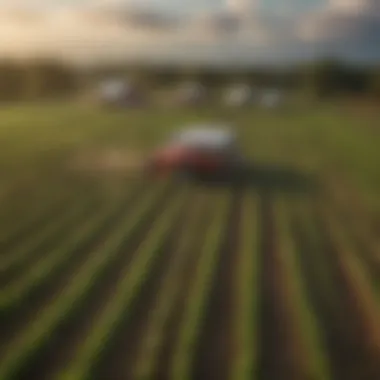Oklahoma's Agricultural Landscape: Practices and Insights


Intro
Oklahoma's agricultural environment is diverse and complex. The state has a varied landscape, with different soil types and climate patterns that greatly influence farming practices. Understanding these factors is essential for farmers and stakeholders in the agricultural sector. This article delves into land and farming practices specific to Oklahoma, illuminating key aspects such as soil conditions, crops cultivated, farming techniques, and economic considerations.
By examining the unique agricultural framework of Oklahoma, this article will provide valuable insights aimed at enhancing farming efficiency. We will explore sustainable practices, land management strategies, and regulatory matters that impact farming operations. Through this lens, we can foster a deeper appreciation for the opportunities and challenges that exist in this vibrant agricultural region.
Research and Data Analysis
Agricultural trends in Oklahoma are shaped by a combination of historical practices and current innovations. Farmers and agronomists increasingly rely on data analysis to inform their decisions. This enables them to adapt to changes in climate and market demands. Understanding both the soil and climatic conditions is crucial for successful cultivation.
Latest Trends in Agriculture and Horticulture
Recent studies indicate a shift toward more sustainable practices among Oklahoma farmers. These trends include:
- Increased use of cover crops: Farmers are recognizing the benefits of cover cropping for soil health.
- Adoption of technology: Precision agriculture tools are being embraced to enhance productivity.
- Diversified cropping systems: Farmers are exploring crop rotations to improve soil nutrition and reduce pest pressure.
These trends contribute to greater resilience in Oklahoma's agricultural systems.
Statistical Insights into Crop Yields
Statistical analysis provides important insights into the performance of various crops. Here are some key observations:
- Wheat yields: Oklahoma is one of the top wheat producers in the United States, with average yields fluctuating around 30 bushels per acre.
- Soybean production: Soybean crops are increasingly grown in the state, reflecting a national trend toward expanded oilseed production.
- Peanut farming: Growing peanuts has also gained traction due to favorable soil conditions in certain regions.
These statistics illustrate the changing dynamics of crop cultivation in Oklahoma, informing farmers about their options and expected outcomes.
Best Practices and Techniques
Incorporating best practices is essential for long-term sustainability in Oklahoma’s agriculture. The following strategies are proving effective:
Efficient Crop Management Strategies
Efficient crop management is achieved through techniques such as:
- Soil testing: Regular soil analysis helps farmers understand soil health and nutrient needs.
- Crop rotation: This practice minimizes soil degradation and pest build-up.
- Water management: Efficient irrigation techniques are crucial in managing water resources.
These approaches foster a resilient agricultural landscape.
Sustainable Horticultural Techniques
Sustainable horticulture encourages practices that maintain ecological balance. Effective techniques include:
- Organic farming: Minimizing the use of synthetic chemicals ensures healthier crop production.
- Integrated pest management: This method combines cultural, biological, and chemical practices to control pests while reducing environmental impact.
- Permaculture principles: Adopting permaculture can lead to ecosystems that support both crops and livestock sustainably.
By adopting these practices, farmers can contribute to the long-term health of their land and the environment.
Pest and Disease Management
Managing pests and diseases is crucial for maintaining crop health. Understanding the common threats helps mitigate risks.
Common Pests and Diseases in Crops
Oklahoma farmers face challenges from various pests. Some notable ones include:
- Wheat curl mite: This affects wheat crops significantly.
- Aphids: They can impact many types of crops, spreading viruses.
- Corn earworm: A major pest in corn production.
Integrated Pest Management Strategies
Integrated pest management focuses on a combination of practices to control pest populations. Key strategies include:
- Surveillance: Regular monitoring of pest populations to assess pressure.
- Biological control: Utilizing natural predators to limit pest numbers.
- Cultural practices: Changing farming practices to reduce pest habitats.
Through proactive management, farmers can protect their yields and promote healthier ecosystems.
Preamble to Agriculture in Oklahoma
Agriculture is a cornerstone of Oklahoma's identity and economy. Understanding agriculture in this state provides insight into how land is utilized for farming, the types of crops that flourish, and the overall economic health tied to agricultural practices. Oklahomans have a long history of farming, shaped by the unique geographical and climatic factors of the region.


The importance of the agricultural sector cannot be overstated. It is vital for food production, supports jobs, and contributes significantly to the state's economy. Around 33,000 farms operate in Oklahoma, covering approximately 44 million acres. This vast expanse of land creates opportunities for diverse agricultural activities.
Overview of Oklahoma's Agricultural Industry
Oklahoma's agricultural industry is characterized by its wide range of products and operations. The state is well-known for its wheat, which plays a significant role in its economy. In addition to wheat, Oklahoma produces cotton, corn, soybeans, and various fruits and vegetables.
The farming operations in Oklahoma vary greatly, from small family-owned farms to larger commercial farms. These farms utilize different techniques and technologies to maximize their yield and efficiency. Hybrid practices focus on both traditional farming methods and modern innovations.
Agricultural research institutions in Oklahoma, such as Oklahoma State University, contribute to the industry by developing sustainable practices and promoting advancements in agricultural technology. This research not only helps support farmers but also aids in increasing the resilience of the agricultural sector.
Importance of Agriculture to the State's Economy
Agriculture represents a critical portion of Oklahoma's economy. In 2021, the total economic impact of agriculture and its related industries was estimated to exceed $40 billion. This impact goes beyond farms and includes jobs in processing, transportation, and retail. The sector supports agribusinesses and contributes to local and state revenues.
Oklahoma's economy relies heavily on international trade as well. Agricultural exports from the state include wheat, cattle, and other produce. These exports help stabilize the local economy, allowing farmers to adapt to domestic market fluctuations.
In summary, agriculture in Oklahoma is not only a way of life for many residents but a critical component driving the state's economy. With ongoing challenges, such as climate change and market variability, understanding Oklahoma's agriculture becomes increasingly important for stakeholders and farmers alike.
Geographical and Climatic Factors
Understanding the geographical and climatic factors is essential for evaluating agricultural practices in Oklahoma. The state's unique terrain and weather patterns play a significant role in shaping the farming landscape, influencing crop selection, farming techniques, and overall productivity. These factors also determine how farmers must adapt to changing environmental conditions and market demands.
Geographical Regions of Oklahoma
Oklahoma features a diverse array of geographical regions, each with distinct characteristics. The state can be divided into several main areas:
- High Plains: Located in the western part, this region is ideal for wheat and other drought-resistant crops. Its flat terrain and well-drained soils offer the advantage of extensive farming.
- Cross Timbers: Stretching across central Oklahoma, this area is known for its mixed woodlands and rolling hills. It's suitable for both crop production and livestock grazing.
- Red River Valley: Situated in the south, this fertile region benefits from abundant water supply, supporting a variety of crops, including cotton and corn.
- Ouachita Mountains: Found in the southeastern part, this mountainous area features less agricultural activity but provides vital resources such as timber and recreational opportunities.
Each region’s unique topography influences the types of agriculture that can thrive there.
Impact of Climate on Farming Practices
The climate in Oklahoma is characterized by extremes. It is primarily continental, which means there are significant temperature variations between seasons. Some key climatic aspects influencing farming practices include:
- Temperature Variability: Hot summers and cold winters can create challenges for crop selection and timing of planting and harvesting.
- Precipitation Patterns: The state experiences irregular rainfall, leading to periods of drought and floods. This variability necessitates adaptive water management strategies.
- Wind: High winds, particularly in the flat regions, can impact soil erosion and crop resilience. Farmers often employ windbreaks to mitigate these effects.
As a result, Oklahoma farmers must be strategic in their approach to crop rotation and water conservation practices, ensuring sustainable productivity.
Soil Types and Their Agricultural Uses
The soil in Oklahoma varies by region, and understanding these differences helps farmers maximize agricultural output.
- Loamy Soils: Common in the Red River Valley, these soils are rich in nutrients, making them suitable for a wide range of crops, including vegetables and grains.
- Clay Soils: Found in some areas of the Cross Timbers, clay soils retain moisture well but can become compacted. This can limit crop root development, requiring careful management.
- Sandy Soils: Present in the western plains, sandy soils drain quickly and are favorable for drought-tolerant crops. However, they require more frequent irrigation.
"Soil health is critical. Good planning about soil types can lead to better yield and environmental care."
Farmers in Oklahoma often conduct soil tests to better understand their land's composition, ensuring they use appropriate fertilizers and amendments to support their crops.
In summary, geographical and climatic factors are foundational to understanding agricultural practices in Oklahoma. Knowledge of these elements equips farmers with valuable insights, guiding them in making informed decisions that can enhance their farming operations.
Key Crops Grown in Oklahoma
Key crops are central to understanding the agricultural landscape in Oklahoma. These crops play vital roles not only in the state's economy but also in its farming practices. Understanding the significance of these staple crops helps us appreciate their impact on local communities and the broader market.
Wheat Production and Its Significance
Wheat is a cornerstone of Oklahoma's agricultural production. In fact, the state is one of the top producers of wheat in the United States. This crop is mainly grown in the western and central regions, where the climate and soil conditions are conducive to wheat farming.
The significance of wheat extends beyond mere production numbers. It contributes substantially to the state's economy, providing jobs and supporting local businesses. Wheat is often used for various purposes, including food products, animal feed, and other industrial uses. Furthermore, the cultivation of wheat employs various farming methods, from traditional practices to modern techniques, reflecting adaptability in farming strategies.
The Role of Cotton in Oklahoma's Economy
Cotton is another major crop in Oklahoma, especially in the southern parts of the state. This fiber crop is known for its high demand in the textile industry. The profitability of cotton influences farmers' decisions on land use and crop rotation strategies.
Cotton farming introduces unique challenges, including pest management and water usage. Farmers often implement innovative techniques to address these challenges, including integrated pest management and precision irrigation. Its economic contribution cannot be overstated, as it supports thousands of jobs in various associated industries, including processing and marketing.
Other Notable Crops: Corn, Soybeans, and More
In addition to wheat and cotton, Oklahoma farmers grow a variety of other crops, like corn and soybeans. Corn is mainly planted for grain, which serves both human consumption and livestock feed. It finds its place in the rotation with other crops, enhancing soil health and reducing pest issues.


Soybeans have gained popularity for their versatility and profitability. They are essential for various food products and serve as a valuable source of protein. The rising demand for plant-based proteins might influence the future trends in soybean production within the state.
Oklahoma’s agricultural industry benefits from a diverse range of crops. This diversity not only provides economic security but also contributes to sustainable farming practices. Understanding these key crops can bolster the strategies farmers employ, promoting long-term viability in agricultural operations.
Farming Techniques and Innovations
Farming techniques and innovations are central to enhancing productivity and sustainability in Oklahoma's agricultural landscape. As the state faces unique challenges such as variable climate and soil conditions, adopting effective farming practices is crucial. These techniques enable farmers to maximize yield, manage resources efficiently, and contribute positively to the environment. The integration of innovation helps to navigate modern challenges while also aligning with economic goals.
Conventional vs. Sustainable Farming Practices
Conventional farming practices typically involve the use of synthetic fertilizers and pesticides. These methods aim for high productivity and quick results. However, there are environmental concerns associated with chemical runoff and soil degradation. In contrast, sustainable farming practices emphasize ecological balance. This includes crop rotation, organic fertilizers, and reducing chemical inputs. The shift to sustainable methods can enhance soil health, reduce water usage, and improve biodiversity on farms.
The benefits of sustainable practices are clear:
- Improved soil quality leads to better crop yields over time.
- Reduced dependence on chemical inputs lowers operational costs.
- Better environmental stewardship enhances community relations and marketability of products.
Precision Agriculture Technologies
Precision agriculture is transforming farming in Oklahoma. This approach uses technology to monitor and manage field variability in crops. Tools like GPS, drones, and soil sensors enable farmers to gain detailed insights into their fields.
For example, remote sensing technology can identify areas of a field that require specific interventions, such as additional water or nutrients. By applying only what is needed, farmers can optimize their resources and reduce waste. The main advantages of precision agriculture include:
- Increased efficiency and productivity.
- Reduced environmental impact through careful resource management.
- Cost savings associated with targeted interventions.
Water Management Strategies
Effective water management is vital in Oklahoma’s agricultural practices. With occasional droughts and variable rainfall, water conservation techniques are essential. Farmers are exploring different strategies:
- Drip irrigation minimizes water loss while delivering moisture directly to the roots of plants.
- Rainwater harvesting allows farmers to collect and store rainwater for use during dry periods.
- Soil moisture monitoring helps determine when to irrigate, ensuring sufficient water without overuse.
Adopting these strategies not only conserves water but also ensures sustainable farming practices in the long term.
"Innovative methods in farming are no longer optional but necessary for the longevity of agriculture in Oklahoma."
Challenges Facing Oklahoma Farmers
The agricultural landscape in Oklahoma is complex and layered. Farmers here face a variety of challenges that can influence their operations significantly. Understanding these challenges is crucial for recognizing the realities of farming in this state. From economic pressures to environmental dynamics, these factors shape the viability and sustainability of farming practices.
Economic Pressures and Market Fluctuations
Oklahoma farmers often navigate a world of unpredictability due to economic pressures and market fluctuations. Global commodity prices play a pivotal role in determining profitability for various crops. For instance, wheat, cotton, and cattle prices can change drastically within a short time, impacting farm incomes and planning. Farmers are not just influenced by domestic markets but also by international trade policies and global events.
"Market volatility calls for agile adjustment strategies and careful financial management."
To mitigate risks, many farmers are adopting practices such as forward contracting. This allows them to lock in prices ahead of time, providing a semblance of stability. Coupled with this, rising operational costs—such as fuel prices and farm inputs—further strain their resources. The need for effective budgeting and financial planning becomes apparent.
Environmental Concerns and Regulations
Environmental issues present significant challenges to Oklahoma's farmers. Water scarcity, soil erosion, and the impact of agricultural runoff are prevalent concerns. Farmers must navigate stringent environmental regulations aimed at preserving natural resources while also maintaining productivity.
Soil health is another pressing element. Farmers face scrutiny regarding practices that can lead to degradation. Techniques that traditionally enhanced yield may now conflict with sustainability principles. Thus, balancing productivity with environmental stewardship is a continuous struggle.
Moreover, compliance with regulations demands additional labor and resources, often placing financial burdens on farmers. It requires a keen understanding of both state and federal laws, which can change rapidly.
Adaptation to Climate Change
Climate change is an overarching challenge that touches all aspects of farming in Oklahoma. Increased frequency of extreme weather events, such as droughts and floods, impacts crop yields and farm operations. Adaptation strategies are essential for resilience.
Farmers are increasingly relying on data-driven approaches to understand weather patterns and soil conditions. Innovations in irrigation technology, such as drip systems or moisture sensors, offer solutions for conserving water. In this context, education on climate-smart agriculture becomes indispensable.
The need for adaptation is not only about immediate changes but also future-proofing agricultural practices. Developing resilient crop varieties and diversifying farming operations can offer some level of protection against climatic unpredictability.
In summary, the challenges Oklahoma farmers encounter encompass economic, environmental, and climatic aspects. Addressing these issues is vital for maintaining the state's agricultural sector and ensuring its growth. Only through proactive measures and innovative solutions can farmers navigate these turbulent waters.
Land Management Approaches
Land management is a critical aspect of agriculture that encompasses various techniques to optimize land use efficiency. In Oklahoma, effective land management approaches help farmers maximize productivity while ensuring environmental sustainability. This section will delve into the importance of land management, highlighting several key strategies: effective land use planning, soil conservation methods, and agroforestry practices.
Effective Land Use Planning


Effective land use planning is essential for balancing agricultural output with sustainable practices. This planning involves assessing land availability, understanding zoning laws, and analyzing soil types. By employing strategic land use, farmers can make informed decisions about crop placement and rotation.
Implementing effective land use planning can lead to multiple benefits:
- Increased Efficiency: Well-planned land use reduces wasted resources and optimizes farming operations.
- Environmental Protection: Protects ecologically sensitive areas by steering farming activities away from them.
- Soil Health: Maintains soil fertility by rotating crops and avoiding overexploitation of specific areas.
Farmers must consider their unique regional climates and soil conditions when planning. Engaging in community discussions can also lead to shared insights and collaborative efforts in land utilization.
Soil Conservation Methods
Soil conservation is key in maintaining the integrity and productivity of farmland. In Oklahoma, various soil conservation methods are implemented to combat soil erosion, enhance fertility, and promote biodiversity.
Some common soil conservation practices include:
- Contour Farming: This technique follows the natural contours of the land, reducing erosion by creating barriers.
- Cover Cropping: Planting cover crops during off-seasons can protect soil from erosion, improve structure, and enhance nutrient levels.
- No-till Farming: This reduces disturbance of the soil, preserving moisture and promoting healthier soil biology.
By adopting these methods, farmers secure the land against degradation, allowing for better long-term agricultural productivity.
Agroforestry and Its Benefits
Agroforestry integrates trees and shrubs into agricultural landscapes, which offers several significant benefits. This approach enhances biodiversity, improves soil health, and contributes to better water management.
Some benefits of agroforestry include:
- Enhanced Biodiversity: Introducing trees into farm systems promotes a more diverse ecosystem, which can lead to natural pest control.
- Soil Improvement: Tree roots enhance soil structure and prevent erosion while contributing organic matter through leaf litter.
- Microclimate Regulation: Trees can create microclimates that can protect crops from wind and provide shade.
Agroforestry aligns with sustainable practices by promoting an ecosystem-based approach to farming.
"Sustainable agriculture recognizes the interconnections between land, water, and biodiversity, highlighting the importance of holistic approaches in farmland management."
The Future of Farming in Oklahoma
Farming in Oklahoma is at a pivotal juncture as various factors shape its future. This evolution hinges on the integration of technology, government policy, and community collaboration. Understanding these elements is essential for farmers, agronomists, and all stakeholders involved in the agricultural sector.
Trends in Agricultural Technology
Technological advancements play a crucial role in transforming farming practices. One significant trend is the adoption of precision agriculture. This approach uses data analytics, GPS, and IoT devices to optimize field-level management regarding crop farming. Farmers can make more informed decisions based on real-time data analysis. For instance, using drones for crop monitoring allows for efficient resource allocation and reduces waste.
Moreover, the development of genetically modified organisms (GMOs) provides new avenues for yield enhancement. These crops can be resistant to pests and drought, thus playing a vital role in ensuring food security in changing climates. As farmers in Oklahoma face unique challenges due to environmental factors, these technologies become more imperative for sustainable and productive agriculture.
Role of Government Policies in Agriculture
Government policies significantly influence agricultural sustainability and growth. In Oklahoma, initiatives such as subsidized crop insurance and funding for research are vital. Support from entities like the USDA helps farmers access funds for innovative practices and technologies. Policies aimed at encouraging conservation practices also empower farmers to adopt sustainable methods without fearing economic downturns.
Moreover, regulations regarding water usage directly impact farming in Oklahoma. Given the state's water scarcity issues, government involvement in establishing responsible use policies is essential. Future legislative focus should include promoting regulations that foster innovation while protecting natural resources, ensuring that farming can thrive in Oklahoma.
Community Support and Agricultural Cooperatives
The strength of agricultural cooperatives lies in their ability to provide farmers with resources and support that individual operations may lack. These organizations facilitate access to better pricing for inputs such as seeds and fertilizers. Additionally, they create a platform for knowledge-sharing among farmers, fostering a culture of learning and collaboration.
Community engagement is also essential in addressing local challenges. Through cooperative efforts, farmers can collectively tackle issues like marketing and distribution, allowing them to enhance profitability. Notably, local farmers' markets and community-supported agriculture programs foster direct connections between farmers and consumers, increasing local support and awareness.
"The future of farming is not just about the land; it’s about the community, technology, and policy shaping how we farm today and tomorrow."
Culmination
The significance of the Conclusion within this article lies in its ability to summarize and synthesize the multifaceted insights gathered regarding land and farm practices in Oklahoma. With a diverse agricultural landscape, Oklahoma showcases a unique blend of geographical and climatic conditions that influence farming methods. Recognizing these aspects is vital for stakeholders within the agricultural sector—farmers, policymakers, and researchers alike.
By understanding the critical challenges farmers face, such as economic pressures and environmental concerns, one can appreciate the necessary adjustments needed for sustainable practices and better land management. Different farming techniques, ranging from conventional to precision agriculture, form the backbone of effective production strategies. These insights also contribute to enhancing the overall efficiency of agricultural operations in the state.
Ultimately, the information presented can guide future practices in Oklahoma agriculture. It allows stakeholders to make informed decisions that can lead to improved yields and economic viability in an ever-evolving industry. It is imperative that the agricultural community remains adaptable to change, leveraging both historical knowledge and emerging innovations to meet future challenges.
Summary of Key Insights
Throughout this article, several key insights emerge:
- Diversity of Crops: Oklahoma's agricultural sector encompasses a variety of crops, each playing a vital role in the state's economy. Wheat, cotton, corn, and soybeans are among the most significant contributors.
- Geographical Influences: The geographical landscape and climate zones provide both advantages and limitations to farming practices. Farmers must consider these factors when planning their crops.
- Sustainable Practices: There is a growing emphasis on adopting sustainable farming methods that prioritize environmental conservation, soil health, and resource management.
- Technological Advancements: Innovations in precision agriculture and water management techniques have revolutionized farming operations, allowing for increased efficiency and production.
"Understanding the intricate relationship between agricultural practices and broader economic and environmental factors is essential for the future of Oklahoma's farming landscape."
Implications for Future Practices
The implications drawn from the insights of this article present a pathway for future agricultural practices in Oklahoma:
- Adaptive Strategies: Farmers must implement adaptive strategies that are responsive to market fluctuations, climate variability, and technological advancements.
- Policy Support: Government initiatives can play a critical role in supporting farmers through favorable policies that encourage sustainable practices and research into innovative farming techniques.
- Community Collaboration: Enhancing support within local communities, such as through cooperatives, can foster collaboration and resource sharing, further empowering farmers to thrive.
- Continual Education: Ongoing education and training can significantly improve farmers’ ability to implement best practices and embrace new technologies.















